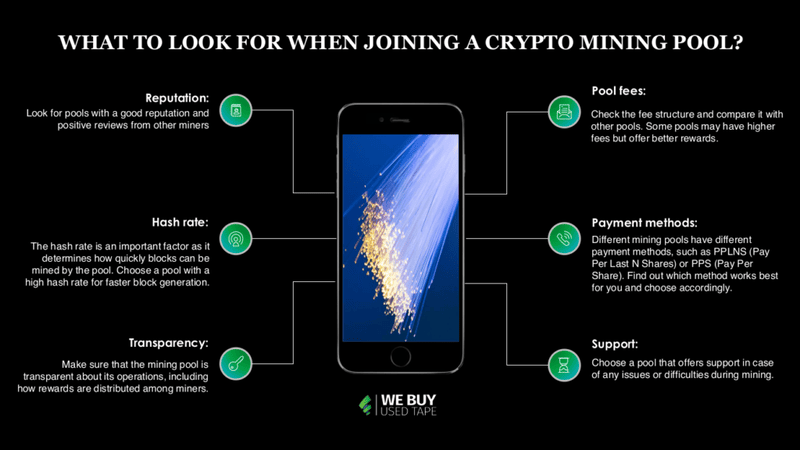How To Choose The Right Cryptocurrency Mining Pool: Factors To Consider

Cryptocurrency mining pools play a pivotal role in the process of mining digital currencies. However, with the increasing number of mining pools available, choosing the right one can be a daunting task.
This article presents an objective and impersonal analysis of the factors that should be considered when selecting a cryptocurrency mining pool.
To begin with, understanding the basics of cryptocurrency mining is crucial. This knowledge enables miners to make informed decisions regarding pool selection.
Researching different mining pool options is the next step, as it allows miners to compare factors such as pool size, fee structures, payout methods, and security measures. Additionally, reading reviews and feedback from other miners, as well as evaluating the pool’s reputation and track record, provides valuable insights into the pool’s performance and reliability.
Furthermore, assessing the effectiveness of a pool’s customer support and communication channels is essential to ensure smooth mining operations. By considering these factors, miners can make a well-informed decision when selecting the right cryptocurrency mining pool for their needs.
Key Takeaways
- Research different mining pool options and compare factors such as reputation, size, fee structure, payout methods, and geographical location.
- Consider the trade-off between joining a large pool for more frequent rewards and the potential impact on decentralization.
- Evaluate pool fees, payout frequency, minimum payout threshold, and additional fees before making a decision.
- Examine a pool’s security measures, reputation, and track record to protect mining activities and rewards.
Understand the Basics of Cryptocurrency Mining
Understanding the fundamental principles of cryptocurrency mining is crucial in order to make informed decisions when choosing a mining pool.
Cryptocurrency mining refers to the process of validating and adding new transactions to the blockchain network. This process requires significant computational power and energy consumption.
Mining pools offer a collective approach to mining, where multiple miners collaborate to increase their chances of solving complex mathematical problems and earning rewards.
When selecting a mining pool, several factors should be considered. These include the pool’s reputation, size, fee structure, payout methods, and geographical location.
A reputable mining pool with a large number of participants can provide a more stable and consistent income. Additionally, the fee structure and payout methods should align with the miner’s preferences and requirements.
It is also important to consider the geographical location of the pool, as it can affect latency and network connectivity, ultimately impacting mining efficiency.
By understanding these basics, miners can make informed decisions when choosing the right mining pool for their needs.
Research Different Mining Pool Options
Researching various mining pool options is crucial when making informed decisions in the cryptocurrency mining industry. With the plethora of options available, it is essential to thoroughly analyze each pool’s features and reputation.
Firstly, consider the pool’s size and mining power distribution. Joining a large pool may provide more frequent rewards, but the distribution of mining power may affect decentralization.
Secondly, evaluate the pool’s fee structure. Some pools charge a percentage of the rewards, while others have a fixed fee. It is important to consider the fees in relation to the potential earnings.
Additionally, assess the pool’s reputation and reliability. Look for pools with a history of consistent payouts and strong security measures.
Lastly, consider the pool’s user interface and the availability of support. A user-friendly interface and responsive support team can greatly enhance the mining experience.
Through thorough research, one can select a mining pool that aligns with their mining goals and preferences.
Consider the Size of the Mining Pool
When assessing mining pool options, it is important to take into account the size of the pool as it can impact the frequency of rewards and the overall decentralization of the network.
A larger mining pool typically has a higher hash rate, which means that it can solve blocks more quickly and distribute rewards more frequently among its participants. However, this also means that the rewards are divided among a larger number of miners, potentially resulting in smaller individual payouts.
On the other hand, a smaller mining pool may have a lower hash rate and less frequent rewards, but the individual payouts may be larger due to the smaller number of participants. Additionally, smaller mining pools contribute to the decentralization of the network, as they prevent a single pool from gaining too much control over the mining process.
Ultimately, the choice of mining pool size depends on the individual miner’s preferences and objectives.
Evaluate the Pool’s Fee Structure
Evaluating the fee structure of a mining pool provides valuable insight into potential costs and profitability for miners, allowing for a more comprehensive analysis of the pool’s financial viability. When choosing a cryptocurrency mining pool, it is important to consider the pool’s fee structure, as it can significantly impact the profitability of mining operations.
Here are five factors to consider when evaluating a pool’s fee structure:
- Pool Fee: Assess the percentage of mining rewards that the pool charges as a fee. Lower pool fees can increase profitability for miners.
- Payout Frequency: Determine how often the pool distributes mining rewards. More frequent payouts can be advantageous for miners, providing a steady stream of income.
- Minimum Payout Threshold: Check the minimum amount required to receive a payout from the pool. A lower threshold allows miners to access their earnings sooner.
- Additional Fees: Look for any additional fees charged by the pool, such as withdrawal fees or maintenance fees. These fees can eat into the overall profitability of mining.
- Fee Transparency: Ensure that the pool provides clear and transparent information about its fee structure. This helps miners make informed decisions and avoid unexpected costs.
Examine the Payout Methods
Examining the payout methods employed by a mining pool is essential for miners to understand how and when they will receive their mining rewards. Different mining pools adopt various payout methods, and miners should consider which method best suits their needs. Two common payout methods are proportional and pay-per-share (PPS). Proportional payout distributes rewards based on the miner’s contribution to the pool’s total hash rate. In contrast, PPS guarantees a fixed payout for each share submitted, regardless of the pool’s overall performance. Other payout methods include score-based systems and pay-per-last-N-shares. Miners should also consider the payout frequency, as some pools distribute rewards daily, while others have longer payout intervals. Evaluating the payout methods allows miners to select a pool that aligns with their expectations and preferences.
| Payout Method | Description |
|---|---|
| Proportional | Rewards based on miner’s hash rate contribution |
| Pay-per-Share (PPS) | Fixed payout per share submitted |
| Score-based | Rewards based on the miner’s score |
| Pay-per-Last-N-Shares | Rewards based on the last N shares submitted |
Assess the Pool’s Security Measures
Assessing the pool’s security measures is crucial for miners to ensure the safety and protection of their mining activities and rewards. When choosing a cryptocurrency mining pool, it is important to consider the security measures implemented by the pool operator.
One key aspect to evaluate is the pool’s authentication process. A robust authentication system can prevent unauthorized access to the mining pool, safeguarding the miners’ accounts and earnings.
Additionally, it is essential to assess the pool’s protection against Distributed Denial of Service (DDoS) attacks. A pool with strong DDoS mitigation measures can ensure uninterrupted mining operations and prevent potential disruptions caused by malicious attacks.
Furthermore, miners should also consider the pool’s track record and reputation in terms of security. Opting for a pool with a proven history of implementing effective security measures can provide miners with peace of mind and reduce the risk of potential security breaches.
Read Reviews and Feedback from Miners
Reviewing feedback and reviews from other miners can provide valuable insights into the overall performance and reliability of a particular mining pool. By analyzing the experiences of other miners, individuals can gain a better understanding of the pool’s efficiency, payout frequency, and customer support.
Here are four key factors to consider when reading reviews and feedback:
- Pool Stability: Determine if the mining pool has a history of downtime or interruptions, as this can impact the profitability of mining operations.
- Payout Process: Assess whether the pool pays miners on time and without any issues, as delayed or incomplete payments can be frustrating.
- Support Responsiveness: Look for feedback on the pool’s customer support, including the speed and effectiveness of their responses to inquiries or issues.
- Reputation: Consider the overall reputation of the mining pool within the cryptocurrency community, as a positive reputation can indicate trustworthiness and reliability.
By carefully reviewing reviews and feedback, miners can make informed decisions when selecting a cryptocurrency mining pool.
Take into Account the Pool’s Reputation and Track Record
Taking into account the mining pool’s reputation and track record is crucial in making an informed decision regarding its reliability and trustworthiness in the cryptocurrency community. A mining pool’s reputation can be assessed by considering factors such as its longevity in the industry, the number of miners it has, and the total hash power it controls. Additionally, it is essential to assess the pool’s track record in terms of its payout frequency and transparency in distributing rewards. By examining these aspects, miners can gain insights into the pool’s stability, efficiency, and fairness. To engage the audience, a table can be included comparing the reputation and track record of different mining pools, including factors such as the pool’s establishment date, number of miners, total hash power, payout frequency, and transparency. This table will provide a visual representation of the information, enabling miners to make a more informed decision.
| Mining Pool | Establishment Date | Number of Miners | Total Hash Power | Payout Frequency | Transparency |
|---|---|---|---|---|---|
| Pool A | 2015 | 10,000 | 100 PH/s | Daily | High |
| Pool B | 2017 | 5,000 | 50 PH/s | Weekly | Medium |
| Pool C | 2013 | 20,000 | 200 PH/s | Monthly | Low |
Test the Pool’s Customer Support and Communication Channels
An essential aspect to consider when evaluating a mining pool is the effectiveness of its customer support and communication channels, as these factors can greatly influence a miner’s experience and success in the cryptocurrency mining process. Reliable and responsive customer support is crucial for addressing any issues or concerns that may arise during mining operations. A mining pool with prompt and efficient customer support can provide timely assistance in troubleshooting technical problems, resolving payment issues, or clarifying any doubts related to the mining process.
Additionally, the availability of multiple communication channels, such as email, live chat, or forums, allows miners to connect with pool administrators and other members for support or discussions. Testing the pool’s customer support and communication channels prior to joining can help ensure a smooth and satisfactory mining experience.
Frequently Asked Questions
How much electricity does cryptocurrency mining consume?
Cryptocurrency mining consumes a significant amount of electricity due to the computational power required to solve complex mathematical problems. The exact amount varies depending on the type of cryptocurrency, mining hardware, and energy efficiency measures employed.
What is the average lifespan of a mining machine?
The average lifespan of a mining machine depends on various factors such as its quality, usage intensity, and technological advancements. However, on average, a mining machine can last for around 2 to 5 years.
Can I mine multiple cryptocurrencies in the same mining pool?
Yes, it is possible to mine multiple cryptocurrencies in the same mining pool. This allows miners to diversify their earnings and maximize their mining capabilities by allocating their resources to different cryptocurrencies within the pool.
Are there any legal regulations or restrictions on cryptocurrency mining?
Legal regulations and restrictions on cryptocurrency mining vary across countries. Some nations have imposed strict regulations, such as banning or heavily taxing mining activities, while others have embraced it with minimal restrictions. Compliance with local laws is crucial when engaging in cryptocurrency mining.
Can I switch mining pools easily if I’m not satisfied with my current one?
Yes, it is possible to switch mining pools easily if one is not satisfied with their current one. Miners can simply choose a different pool and reconfigure their mining software accordingly.








